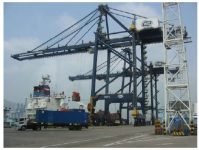
RFID has developed rapidly in the field of container management
[ad_1]
In the global circulation of goods, containers are used as carriers for transportation from all over the world, especially sea containers. Container manufacturers and container transportation management enterprises undertake a large number of heavy statistical management tasks such as production and transportation, finished product transportation, and stacking storage. RFID radio frequency identification technology is favored by the container transportation industry because of its fast identification speed, high reading accuracy, no contact, and strong environmental adaptability. RFID has developed rapidly in the field of container management.
After the container is produced and shipped, RFID technology collects the location and status data of the container. RFID technology can adapt to the harsh environment of the container production line and the metal box group of the yard. Real-time tracking to realize the management of containers (container production management), consignment vehicles (automatic freight settlement) and automatic management of yards (container storage status).

The application of RFID technology in the container field enables accurate control and tracking of container information. Compared with applications in industrial automation and other fields, the application of RFID electronic tags in container logistics transportation has a strong particularity. RFID electronic tags flow with containers on the sea, docks, storage yards and other places. The working environment has a temperature difference and can be applied to various harsh environments.
RFID container management system composition
RFID card issuers, RFID readers, RFID electronic tags (container electronic tags and trailer electronic tags), antennas, on-board reader systems, factory exit monitoring subsystems, yard automatic management subsystems, and central monitoring subsystems.
(1) Central monitoring center subsystem: monitors the operation of other subsystems, and exchanges information with other subsystems. Carry out container information management and consignment vehicle information management, data statistics and analysis, freight settlement, and provide customers with container information query services.
(2) The factory monitoring subsystem: monitors and records the information of the factory container, the information of the consigned vehicle, the occurrence time, the operator, etc. Statistically analyze the delivery status of various containers.
(3) Yard container management system: monitor and record the information of containers passing through the gate, corresponding haulage vehicle information, event occurrence time, operators and other information, manage the container stacking position information in the yard, and quickly and accurately find the status of the container; It has a vivid 2D container yard map and functions of placing and finding containers.
RFID container management workflow
(1) Write card in container workshop. When the manufactured finished container is off the production line, the corresponding container information such as the container code is written into the blank RFID electronic tag through the system software and the card writer, and the label with the written code is adsorbed on the container, and the stacker truck of the production plant The reader system confirms the container number and leaves the factory.
(2) The factory reads the container. Confirm that the factory container will be transported out of the production plant by trailer to the storage yard, and the reader installed at the factory’s export will read the container label information and trailer information (if the label reading fails, the export monitoring point staff can manually enter the box number) and transmit it to the factory In the monitoring subsystem, the system is then uploaded to the central monitoring subsystem through the Internet network.
(3) Reading at the entrance of the yard gate. When the container enters the yard gate, the RFID reader at the yard entrance gate reads the container and vehicle RFID electronic tags, and saves the vehicle information, container information and its matching relationship, arrival time, etc. in the yard management subsystem. Upload to the central subsystem at the same time.
(4) Place/pick up containers in the yard. After the containers enter the storage yard, the stacker truck system places the containers according to the stacking position allocated by the central subsystem. The vehicle-mounted reader automatically reads the information of the captured container, and the data interacts with the central database of the control room through wireless data transmission. After verification, the container is stacked to the position indicated by the system graphics. When picking up the container, the stacker truck system finds the corresponding container according to the graphic instructions, the reader reads the electronic tag on the container, and it is verified that the container should be removed after being picked up.
(5) When the container is shipped out of the yard. The reader system at the exit of the storage yard reads the labels of the containers and vehicles that are out of the field, judges whether the containers should be out of the field, and after confirmation, matches the vehicle information and the box information, and saves the information and the departure time in the local database and the central database (MAS database). If the container information is successfully read, the staff will remove the label for recycling and enter the next round of applications.
Readers are installed at key points such as the entrance of the container factory and the entrance and exit of the storage yard to realize dynamic reading of tags without stopping, which speeds up the delivery, transportation, and storage of offline products, improves the accuracy of information collection, and reduces staff Manual work in harsh environments.
RFID technology has been widely used in container management. RFID technology can achieve accurate real-time container history and current status, historical records of transport vehicles, storage location, records and queries of yard containers, thereby realizing container production and yard data Management, vehicle transportation record management, real-time data transmission and real-time transparency of container supply chain information.
[ad_2]



